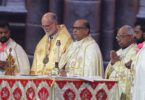
Altar servers listen during a November 2015 Mass at St. Jerome Catholic Church in Jerome, Idaho. Catholic leaders say if there is to be a strong 22nd-century mission church, the mission church of the 21st century must foster solid Catholic values among the young and teach them how the faith will enrich their lives. (CNS photo/Chaz Muth)
by Chaz Muth
BOISE, Idaho (CNS) — It was early on a Sunday morning near Jerome, Idaho, and Esmeralda Orozco was busy helping her daughters get ready for church.
“We want you to look nice,” Orozco said to one of her girls as she brushed her long, dark hair.
She said her daughter’s appearance was especially important that morning because she was getting ready to be an altar server for Mass at nearby St. Jerome Catholic Church.
Orozco believes it’s her duty as a parent and as a Catholic to prepare her children to be future leaders in the church.
She and her husband, Jorge, both play principal roles at their parish. She is an extraordinary minister of holy Communion; he plays the organ and operates the audiovisual apparatuses. Both volunteer in other ways in their faith community, having served on various boards and committees.
So now they are laying the foundation for their children to do the same by getting them involved in the church as young as possible.
It’s not enough for them just to go to Mass and religion class, it’s their duty as Catholics to serve the church as well, Orozco told Catholic News Service.
These are the kinds of values that will help secure the future of U.S. Catholic home mission dioceses, said Boise Bishop Peter F. Christensen, who is the former chair of the U.S. bishops’ Subcommittee on Catholic Home Missions.
If there is to be a strong 22nd-century mission church, the mission church of the 21st century must foster solid Catholic values among the young and teach them how the faith will enrich their lives, Bishop Christensen said.
The U.S. church has traditionally done this in its Catholic schools. However, there tends to be fewer of them in home mission dioceses, he said.
For instance, the statewide Diocese of Boise has only 13 Catholic grade schools and one Catholic high school.
So, with help of the funding from the Catholic Home Missions Appeal, the diocese has focused on programs that engage the next generation of Catholics through youth ministry in the parishes, campus ministry at the colleges, marriage preparation for young adults and marriage enrichment to help newlyweds build a strong foundation for a lasting relationship.
“The sad reality is that society, be it Catholic or secular, is divorcing at a 50 percent rate and it’s just a little bit less than that within the church,” said Jerome Cabeen, director of the Office of Family Life Ministry in the Diocese of Beaumont, Texas, another of the country’s mission dioceses. “So, you really encourage these younger couples to look at these couples who have been married 60 years and really emulate some of the things that they did.”
It also is important to reach out to the younger generation who are Catholic in name only but have no meaningful involvement with the church, said Beaumont Bishop Curtis J. Guillory during an interview with CNS.
Bishop Guillory has been trying to meet with young couples and singles who attend Mass to find out what spiritual needs they have that the church is not meeting.
Then he asks them, “How do you advise us to evangelize your peer group, your companions?”
“I’ve found that to be very enriching and very inspiring,” Bishop Guillory said. “Those who remain in the church are very committed . . . and they want to bring others.”
The growing Latino presence in the country’s mission dioceses has been “a positive influence among all of the faithful, but especially the young people,” Bishop Christensen said.
“For most of the Latinos, it’s not just an hour of church on Sunday,” he said. “The parish is often at the center of their lives. It’s where they worship, but it’s also where they have built their social life.
“They receive a lot from the church, but they give so much back in all of the work they do in the church,” Bishop Christensen said. “The young people are seeing this. It’s a great witness.”
What these mission dioceses also need from the young is a total commitment to the church through vocations, because there are just not enough priests to serve each and every faith community exclusively, said Lynne Green, a parishioner of Good Shepherd Catholic Church in Driggs, Idaho.
Many priests are in charge of more than one parish, sometimes as many as four, she pointed out.
“We need priests. People need to raise their sons to be priests,” said Green, whose daughter is a vowed religious sister. “More deacons would help, too.”






